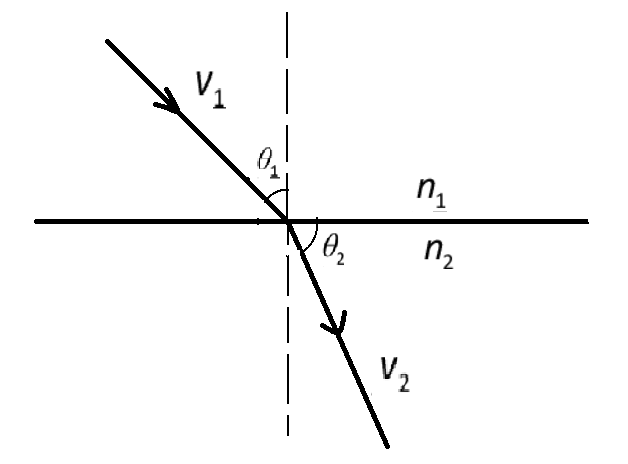
(a)State Snell’s law for refraction of light.
(b)A concave mirror forms two times magnified and real images of an object placed at 15cm from its pole. Determine the distance of image from the mirror and focal length of the mirror.
Answer
492.9k+ views
1 likes
Hint: Snell’s law talks about the relation between incidence and refraction angles and is defined by the ratio of
Complete step by step answer:
a) The light normally bends, or refracts, as light passes from one medium to another. The refraction law gives us a way to estimate how much bend is produced and it is defined by Snell’s law.
The Snell’s law is a law used to explain the relationship between incidence and refraction angles when applied to light or other waves moving across a boundary between two distinct non-opaque materials, such as water, glass or air.
Snell's law states that the sin ratio of incidence and refraction angles is equal to the ratio of phase velocities of all media or identical to the inverse ratio of refraction indices and is given by:
b) It is given that the concave mirror forms two times magnified and real images of an object placed at 15cm from its pole.
So,
Now as,
Substitute,
Therefore, the image formed is 30 cm away from the pole.
Now, as focal length is calculated by
Now, substitute
 Therefore, the focal length of the mirror is 10 cm.
Therefore, the focal length of the mirror is 10 cm.
Note: This is a question is of ray optics, Snell’s law is the basis of ray optics, it is defined for both reflection and refraction and the second part is focusing on the image formation where we need to find the image distance using
Complete step by step answer:
a) The light normally bends, or refracts, as light passes from one medium to another. The refraction law gives us a way to estimate how much bend is produced and it is defined by Snell’s law.
The Snell’s law is a law used to explain the relationship between incidence and refraction angles when applied to light or other waves moving across a boundary between two distinct non-opaque materials, such as water, glass or air.
Snell's law states that the sin ratio of incidence and refraction angles is equal to the ratio of phase velocities of all media or identical to the inverse ratio of refraction indices and is given by:
b) It is given that the concave mirror forms two times magnified and real images of an object placed at 15cm from its pole.
So,
Now as,
Substitute,
Therefore, the image formed is 30 cm away from the pole.
Now, as focal length is calculated by
Now, substitute

Note: This is a question is of ray optics, Snell’s law is the basis of ray optics, it is defined for both reflection and refraction and the second part is focusing on the image formation where we need to find the image distance using
Latest Vedantu courses for you
Grade 10 | CBSE | SCHOOL | English
Vedantu 10 CBSE Pro Course - (2025-26)
School Full course for CBSE students
₹35,000 per year
Recently Updated Pages
Master Class 12 Business Studies: Engaging Questions & Answers for Success

Master Class 12 English: Engaging Questions & Answers for Success

Master Class 12 Social Science: Engaging Questions & Answers for Success

Master Class 12 Chemistry: Engaging Questions & Answers for Success

Class 12 Question and Answer - Your Ultimate Solutions Guide

Master Class 12 Economics: Engaging Questions & Answers for Success

Trending doubts
Give 10 examples of unisexual and bisexual flowers

Write a short note on Franklands reaction class 12 chemistry CBSE

The amine A when treated with nitrous acid gives yellow class 12 chemistry CBSE

A ray of light is incident normally on the surface class 12 physics CBSE

An example of ex situ conservation is a Sacred grove class 12 biology CBSE

Who discovered the cell and how class 12 biology CBSE




